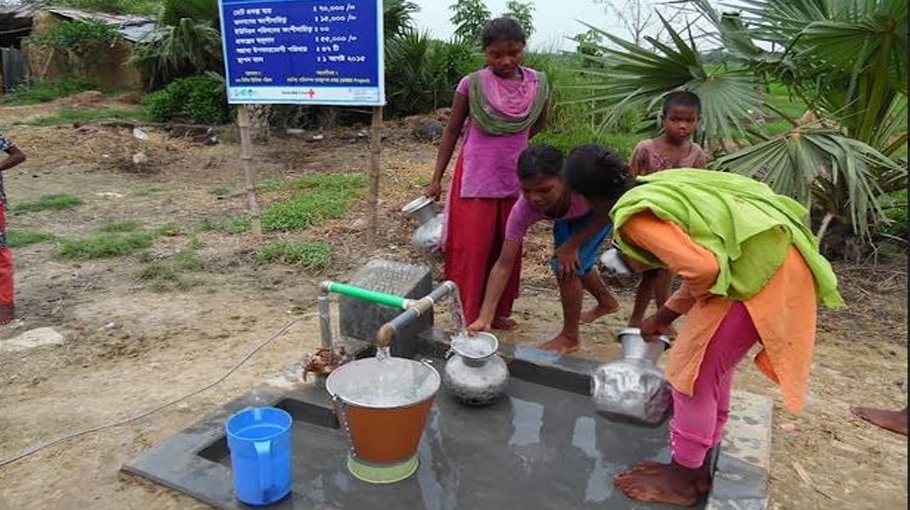4.5 lakh people enjoy water facilities in Barind areas

Around 4.5 lakh people consisting of male, female, ethnic minorities and disabled are enjoying water facilities amid various demand-driven physical infrastructure developments in the drought-affected Barind areas.
Platforms have been constructed for 2,366 community-level tube-wells benefitting 31,647 people, while 4,479 other people are seen getting benefits from 352 rainwater harvesting systems.
A total of 373 ponds with an area of 52,859 feet and 28 canals with an area of 52,164 feet were re-excavated to benefit the commoners besides reducing the gradually mounting pressure on underground water in the Barind area.
The development works were implemented on behalf of a recently phased-out project titled: "Integrated Water Resource Management (IWRM)" for sustainable management of existing water resources in the drought-affected area.
Swiss Red Cross and DASCOH Foundation have jointly implemented the project in drought-affected 39 unions and three Pourasavas under Rajshahi, Chapainawabganj and Naogaon districts supported by Switzerland during the period from 2015 to 2023.
Around 1.25 lakh people including 51,703 women and 19,201 ethnic minorities are being benefited from the ponds while 37,716 others, including 16,065 female and 5,392 ethnic minorities, from the re-excavated canals.
Akramul Haque, chief executive officer of DASCOH Foundation, said the ventures have created scopes of saving around 1.2 crore litre of underground water in terms of household use while 5.47 million liters for livestock rearing.
The beneficiaries are using the pond water to irrigate 1,508 hectares of land as supplementary irrigation. They are also using the canal water to irrigate 850 hectares of farming fields of wheat, mustard, pulse and other Rabi crops as supplementary irrigation.
Marginalized farmers, including ethnic minority ones, are seen derivingbenefits of the re-excavated ponds and canals for irrigation purposes.
Farmers were gradually becoming accustomed to irrigating their cropping fields with canal water in the water-stressed Barind area, contributing a lot towards boosting crop production.
Around 1.38 lakh people, including 48,221 females and 40,598 ethnic minorities, have been brought under safe drinking water sources through commissioning of 592 submersible pumps in the high Barind tract.
The beneficiary people took the responsibility of proper maintenance and function of the infrastructures routinely.
Some of the households have become successful in this field of exploring,collecting and conserving rainwater in the Barind area during the last couple of years inspiring many others to follow the path.
Akramul Haque said various other need-based infrastructures were installed focusing on drip irrigation, concretized irrigation drain, irrigation pipeline and solar based drip irrigation for successful water resource management.
As a whole, the IWRM Project has built sustainable and effective institutions through farmers' level piloting of different sustainable water resource management models through participation of local people.
Korneleus Tudu, 56, and Paulus Tudu, 50, of Barsapara village in Dewpara Union under Godagari upazila in Rajshahi district, have been harvesting rainwater and inserting those to the underground for the last around four to five years.
They have arrangements of harvesting all the rainwater from the rooftop of their tin-shed house and later injecting those to the underground.
Korneleus Tudu told the news agency that the continuous artificial aquifer recharge has already started benefiting them.
They are using the conserved water for household purposes through taps fixed in the lower part of the tank. Surplus water is being preserved in the recharge tank through another upper portion wide pipe.
Tudu said they had to suffer a lot due to the water crisis as there was no water in hand-driven tube-wells from March to June every year. But, the trouble started tiding over for promoting Managed Aquifer Recharge (MAR), a modern technology of artificial aquifer recharge, at present.
Not only the two neighbours but also many other households, business establishments and local government institutions have installed the similar
technology in the drought-hit area.
Prof Mijanur Rahman from Department of Geography and Environmental Sciences in Rajshahi University (RU) stressed the need for re-excavation of more derelict water bodies like canals, ponds and wetlands for the conservation of surface water to maintain ecological balance in the region.
He said a large number of water bodies have become derelict due to the adverse impacts of climate change, posing a serious threat to the ecosystem and livelihood condition of the people.
Substantial and sustainable conservation of surface water resources along with its careful use can be a vital means of supplementing the government
efforts of successful implementation of Delta Plan 2100.



